Physical Address
304 North Cardinal St.
Dorchester Center, MA 02124
The 2014 American College of Cardiology (ACC)/American Heart Association (AHA) guidelines strongly recommend (class I) prompt surgical correction of mitral regurgitation (MR) for patients in stages D (severe symptomatic MR) and C2 (severe asymptomatic MR with left ventricular ejection fraction [LVEF] < 60% or left ventricular end-systolic diameter [LVESD] > 40 mm). Recently, several studies have supported the advantages of surgical correction of primary MR, even in patients in stage C1 (severe asymptomatic MR with LVEF > 60% or LVESD < 40 mm) to prevent excess long-term mortality and heart failure risks.
Modified cardiopulmonary bypass techniques were introduced in 1995 and enabled safe and effective minimally invasive mitral valve surgery. However, difficulties performing complex mitral valve repair using two-dimensional vision and long-shafted instruments limited their adoption. During the late 1990s, development of the da Vinci Surgical System (Intuitive Surgical, Sunnyvale, CA) made safe robotic cardiac surgery possible. The da Vinci Surgical System has allowed surgeons to perform complex reconstructive operations using a combination of telemanipulation and three-dimensional (3D) visualization. The first robotic mitral valve operation was performed by Carpentier et al. in 1998 using the da Vinci Surgical System. In 2000, Dr. Chitwood and colleagues at East Carolina University (ECU) performed the first mitral valve repair in the United States as part of the initial US Food and Drug Administration (FDA) clinical trial.
The most important benefits of robotic mitral valve surgery include excellent surgical dexterity with precise movements of instruments in the closed chest, high-definition 3D visualization with the line of vision parallel to the flow of the blood into the valve, excellent visualization of the subvalvular apparatus, and superior cosmetic results, with more rapid recovery than with the use of conventional approaches.
The heart is covered anteriorly by the body of the sternum and the third to sixth costal cartilages of both sides. The coronary sulcus, separating the atria and ventricles, spans from the upper medial end of the third left costal cartilage to the middle of the right sixth chondrosternal joint. The anterior interventricular sulcus spans from the third left intercostal space (ICS) 2.5 cm to the left of the midline to a point 1.2 cm medial to the apex. The aortic valve is at the level of the third ICS behind the sternum. The pulmonary valve is at the level of the left third ICS. The tricuspid valve is behind the sternum at the level of the fourth to fifth intercostal junction. The mitral valve is located behind the sternum at the level of the fourth intercostal junction.
The mitral valve apparatus consists of the anterior and posterior leaflets, two commissures, which are the areas where the anterior and posterior leaflets meet, the mitral annulus, and the subvalvular apparatus, including the chordae tendineae and papillary muscles ( Fig. 21.1 ).
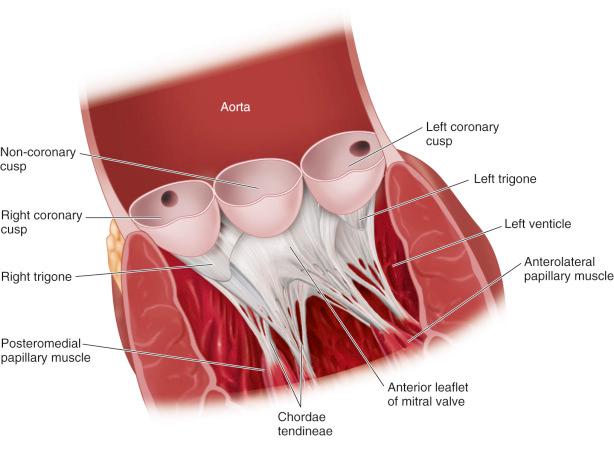
Each leaflet has three segments including the A1 (anterior segment), A2 (middle segment), and A3 (posterior segment) of the anterior leaflet and P1 (anterior scallop), P2 (middle scallop), and P3 (posterior scallop) of the posterior leaflet. The anterior mitral annulus shares fibrous continuity with the aortic valve annulus (left coronary cusp and half of the noncoronary cusp) and is also adjacent to the atrioventricular node and the bundle of His. The circumflex artery courses along the posterior annulus and is at risk of injury during mitral valve repair or replacement ( Fig. 21.2 ). The subvalvular apparatus includes two papillary muscles (anterolateral and posteromedial) and the thin fibrous structures—chordae tendineae—that support both leaflets and prevent leaflet prolapse. The primary chordae attach to the free margin of the leaflets, and the secondary and tertiary chordae insert into the leaflet body, closer to the annulus.
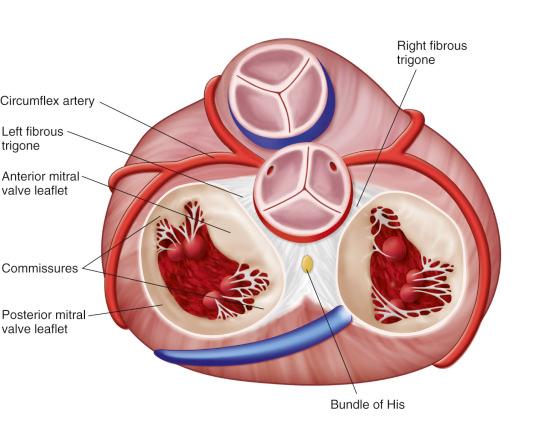
Degenerative, ischemic, rheumatic, and infectious processes are the major causes of mitral valve disease and can affect any component of the valve or subvalvular apparatus. Robotic mitral valve surgery is appropriate for both degenerative and functional mitral valve disease. However, degenerative mitral valve disease is the most common indication for robotic surgery. Furthermore, concomitant left atrial appendage (LAA) closure, ablation for atrial fibrillation, and tricuspid repair can also be performed using the same robotic platform.
Following the 2014 ACC/AHA guidelines, in centers with expertise in both mitral valve and robotic surgery, most patients with severe primary MR with appropriate vascular and coronary anatomy may reasonably be considered for early robotic mitral valve repair, regardless of the complexity of mitral valve disease. Patients should be screened for comorbid conditions that may preclude the selection of the robotic technique. Table 21.1 demonstrates plausible and relative contraindications to robotic mitral valve surgery. However, many of the relative contraindications can be managed to allow a safe robotic mitral valve operation.
| CONTRAINDICATIONS | RELATIVE CONTRAINDICATIONS |
|---|---|
| Previous right thoracotomy | Previous sternotomy |
| Significant aortic root, ascending aortic dilation | Mild aortic stenosis or regurgitation |
| Moderate or severe aortic valve regurgitation | Reduced left ventricular function (EF < 50%) |
| Severe pulmonary hypertension (>50 mm Hg) | Variable pulmonary hypertension (>50 mm Hg) |
| Right ventricular dysfunction | Limited peripheral vascular disease |
| Generalized peripheral vascular disease | Chest deformity (pectus, scoliosis) |
| Contraindications to retrograde perfusion (e.g., aortoiliac atherosclerotic disease) | Asymptomatic mild coronary disease |
| Mitral annular calcification | Moderate pulmonary dysfunction |
| Myocardial infarction or ischemia < 30 days | Asymptomatic cerebrovascular disease |
| Coronary artery disease requiring CABG | |
| Severe pulmonary dysfunction | |
| Symptomatic cerebrovascular disease or stroke < 30 days | |
| Severe liver dysfunction | |
| Significant bleeding disorder |
Repair techniques in patients with functional valve disease relate to the degree of annular and ventricular dilation, papillary muscle displacement, dynamic cardiac function, and degree of leaflet tethering.
Patients at risk for coronary artery disease should undergo a cardiac catheterization or computed tomography (CT) angiography. Patients with significant risk factors for carotid or peripheral vascular disease should be screened by ultrasound and CT. A right heart catheterization may be indicated for patients who have significant pulmonary hypertension, particularly with depressed right ventricular function. Finally, patients with sternal or thoracic deformities should be evaluated by CT to determine whether robotic instrument trajectories will be compromised. A transthoracic echocardiography (TTE) or transesophageal echocardiography (TEE) study should be performed to confirm the diagnosis and determine the repair plan. TEE is also essential in the operative room to delineate mitral valve anatomy in detail, and intraoperative femoral ultrasound should be peformed to confirm the adequacy of vessels for cannulation.
All patients undergoing robotic mitral valve surgery undergo the following steps:
Patient setup and port placement
Cannulation, docking of robotic arms, and exposure of the mitral valve
Mitral valve surgery, tricuspid valve repair, and atrial fibrillation procedures
Weaning from bypass, decannulation, and closing of incisions
The patient is intubated with a double-lumen endotracheal tube, and a TEE probe is placed. Pulmonary artery vent and retrograde coronary sinus cardioplegia catheters (CardioVations, Ethicon, Somerville, NJ) may be placed via the right internal jugular vein under TEE guidance. The patient is positioned at the right edge of the operating room table with a transverse roll under the chest and an arm board supporting the right arm. The right femoral artery and vein are exposed via an oblique incision above the groin crease and assessed for appropriateness for cannulation.
Port placement is done after femoral vessel exposure has confirmed adequacy for use in cannulation for cardiopulmonary bypass. Local anesthetic may be used at all port sites to aid with postoperative pain control. The endoscope camera port is placed in the fourth ICS, 2 to 3 cm lateral to the nipple. In female patients, the breast is retracted superiorly and the incision is placed in the inframammary crease to enter the chest in the fourth or fifth ICS. The working port incision (for a 15-mm soft rubber retractor) is placed in the fourth ICS 4 cm lateral to the camera port. The left instrument port is placed one interspace above and approximately halfway between the shoulder and the camera port. The right instrument port is two or three interspaces below and near the anterior axillary line. The fourth robotic port, for the atrial retractor instrument, is placed in the fifth ICS medial to the camera port. A 10-G angiocatheter, which can accommodate the so-called crochet hook for suture retrieval, is placed in the midaxillary line for posterior pericardial traction sutures. Two other angiocatheters are placed medially and laterally to the central angiocatheter. A Chitwood transthoracic cross-clamp and a small suction vent are placed via stab wounds in the axilla ( Fig. 21.3 ).
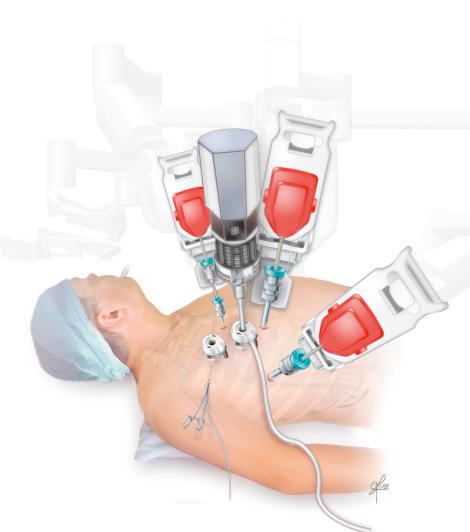
A purse-string suture is placed in the anterior surface of the femoral vein, and then a guidewire is passed through the femoral vein and into the superior vena cava (SVC) under TEE guidance. Seeing the guidewire pass up into the SVC is very important to ensure the proper positioning of the venous cannula. A 25F CardioVations Quickdraw venous cannula is passed over the wire and positioned so that the tip is several centimeters up the inferior vena cava (IVC). The femoral artery is cannulated using the Seldinger technique ( Fig. 21.4 ). Cardiopulmonary bypass is initiated.
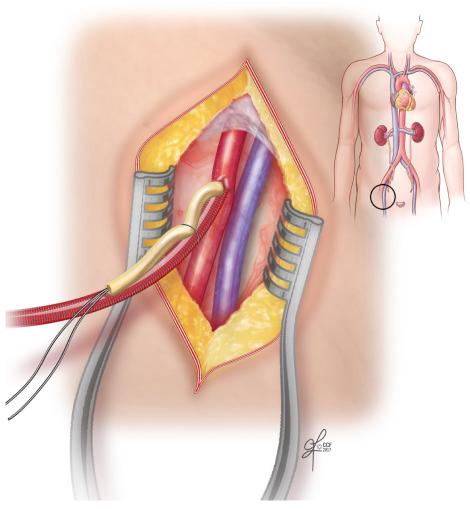
The pericardium is opened with electrocautery anterior to the phrenic nerve. The pericardiotomy extends from near the IVC to up over the ascending aorta. Two traction sutures are placed on the posterior pericardial edge to expose the site of the left atriotomy. A traction stitch on the anterior pericardium facilitates aortic exposure ( Fig. 21.5 ).
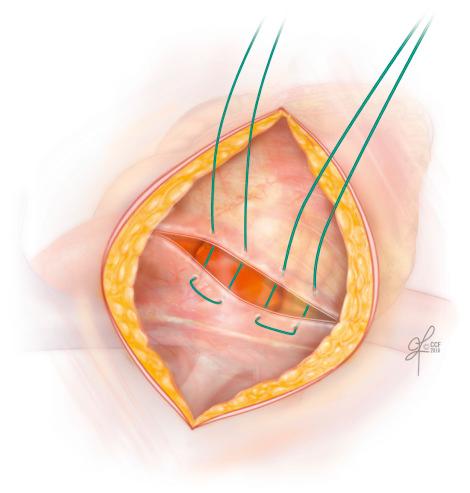
The table is rotated 15 degrees to the left and placed in reverse Trendelenberg to lower the hips and gain extra clearance for the right instrument arm of the robot. The da Vinci robot is brought to the surgical field; the arms are connected to the ports, and the camera and instruments are introduced into the chest.
Become a Clinical Tree membership for Full access and enjoy Unlimited articles
If you are a member. Log in here